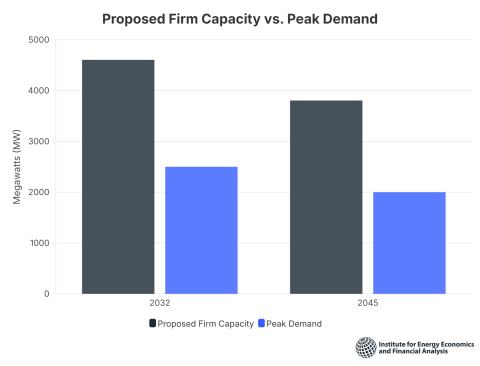Risks outweigh rewards for investors considering PJM natural gas projects
Download Full Report
View Press Release
Key Findings
Development has become increasingly perilous in the past several years, and there is rising uncertainty about the financial viability of new gas plant projects.
In this report, Applied Economics Clinic and IEEFA have identified six overarching threats that pose growing risks for investors in new PJM gas-fired power plants.
Executive Summary
The threats are:
- Increasing price competitiveness of clean solar, wind, demand response and battery storage alternatives. Renewable energy will grow in PJM as costs continue to fall, making it more economic than conventional fossil resources. Load flexibility resources like battery storage, demand response and energy efficiency also will become increasingly important, helping to integrate high levels of renewable generation.
- Significant existing overcapacity, flat demand growth and market turmoil. PJM’s summer reserve margin in 2018 was almost 33 percent, more than twice the ISO’s target, undercutting the need for any new capacity. U.S. regulators ordered changes to PJM’s capacity market that resulted in controversy; the dispute has delayed the ISO’s capacity auction by almost a year, with no certainty about when or how it will be resolved.
- High-impact, unpredictable global events such as COVID-19 that radically reshape markets and expectations of future demand. The pandemic cut daily peak load in PJM by roughly 13.5 gigawatts (GW), and the system operator says it may be 2023 before demand fully recovers.
- Uncertainty over the future direction of gas prices, particularly given the substantial increase in U.S. liquefied natural gas (LNG) exports. U.S. gas prices are now increasingly tied to international markets, making long-term predictions increasingly uncertain and significantly raising risks for new gas plant development.
- Actions by state governments within the PJM market to limit future fossil fuel generation and/or even withdraw from the market entirely. Illinois, New Jersey and Virginia already have aggressive clean energy goals that likely will limit future fossil fuel plant development; other states in the region are weighing similar actions. Illinois, Maryland and New Jersey are considering exiting PJM.
- Public opposition that can delay project development and raise overall costs. Projects must overcome both local opposition, stemming from concerns about water and air quality impacts, as well as broader regional and national concerns about contributions to climate change. Delays are costly and raise the possibility of major changes in the marketplace before the project is completed.














